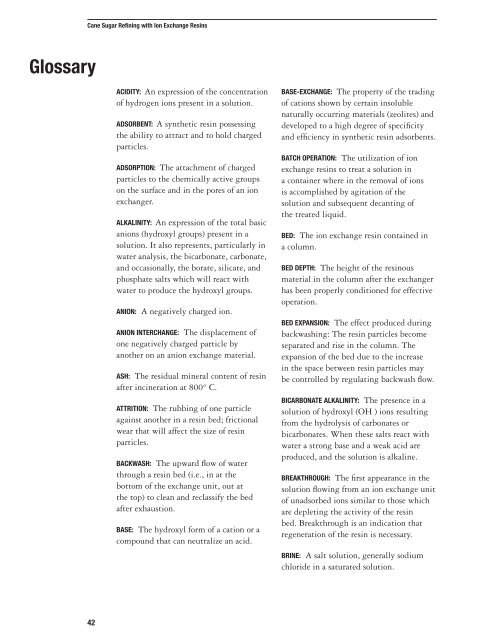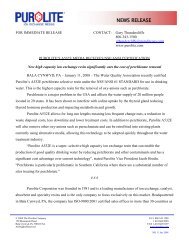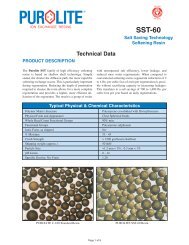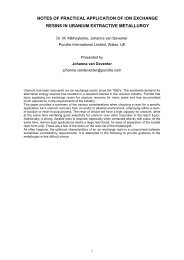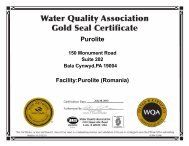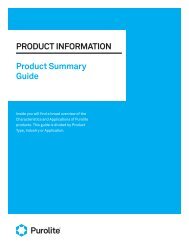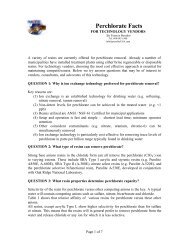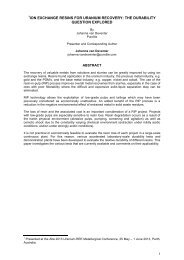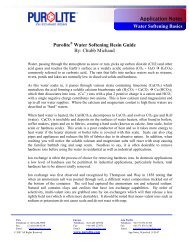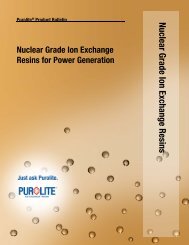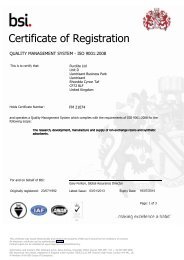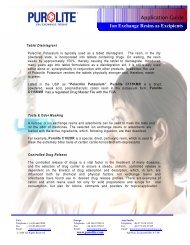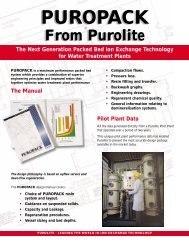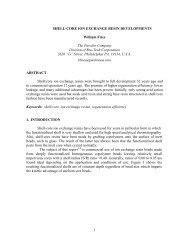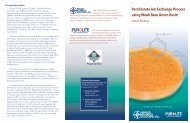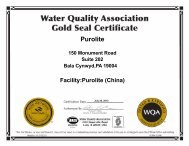Cane Sugar Refining - Purolite
Cane Sugar Refining - Purolite
Cane Sugar Refining - Purolite
Create successful ePaper yourself
Turn your PDF publications into a flip-book with our unique Google optimized e-Paper software.
Glossary<br />
<strong>Cane</strong> <strong>Sugar</strong> <strong>Refining</strong> with Ion Exchange Resins<br />
42<br />
ACIDITY: An expression of the concentration<br />
of hydrogen ions present in a solution.<br />
ADSORBENT: A synthetic resin possessing<br />
the ability to attract and to hold charged<br />
particles.<br />
ADSORPTION: The attachment of charged<br />
particles to the chemically active groups<br />
on the surface and in the pores of an ion<br />
exchanger.<br />
ALKALINITY: An expression of the total basic<br />
anions (hydroxyl groups) present in a<br />
solution. It also represents, particularly in<br />
water analysis, the bicarbonate, carbonate,<br />
and occasionally, the borate, silicate, and<br />
phosphate salts which will react with<br />
water to produce the hydroxyl groups.<br />
ANION: A negatively charged ion.<br />
ANION INTERCHANGE: The displacement of<br />
one negatively charged particle by<br />
another on an anion exchange material.<br />
ASH: The residual mineral content of resin<br />
after incineration at 800° C.<br />
ATTRITION: The rubbing of one particle<br />
against another in a resin bed; frictional<br />
wear that will affect the size of resin<br />
particles.<br />
BACKWASH: The upward flow of water<br />
through a resin bed (i.e., in at the<br />
bottom of the exchange unit, out at<br />
the top) to clean and reclassify the bed<br />
after exhaustion.<br />
BASE: The hydroxyl form of a cation or a<br />
compound that can neutralize an acid.<br />
BASE-EXCHANGE: The property of the trading<br />
of cations shown by certain insoluble<br />
naturally occurring materials (zeolites) and<br />
developed to a high degree of specificity<br />
and efficiency in synthetic resin adsorbents.<br />
BATCH OPERATION: The utilization of ion<br />
exchange resins to treat a solution in<br />
a container where in the removal of ions<br />
is accomplished by agitation of the<br />
solution and subsequent decanting of<br />
the treated liquid.<br />
BED: The ion exchange resin contained in<br />
a column.<br />
BED DEPTH: The height of the resinous<br />
material in the column after the exchanger<br />
has been properly conditioned for effective<br />
operation.<br />
BED EXPANSION: The effect produced during<br />
backwashing: The resin particles become<br />
separated and rise in the column. The<br />
expansion of the bed due to the increase<br />
in the space between resin particles may<br />
be controlled by regulating backwash flow.<br />
BICARBONATE ALKALINITY: The presence in a<br />
solution of hydroxyl (OH ) ions resulting<br />
from the hydrolysis of carbonates or<br />
bicarbonates. When these salts react with<br />
water a strong base and a weak acid are<br />
produced, and the solution is alkaline.<br />
BREAKTHROUGH: The first appearance in the<br />
solution flowing from an ion exchange unit<br />
of unadsorbed ions similar to those which<br />
are depleting the activity of the resin<br />
bed. Breakthrough is an indication that<br />
regeneration of the resin is necessary.<br />
BRINE: A salt solution, generally sodium<br />
chloride in a saturated solution.


